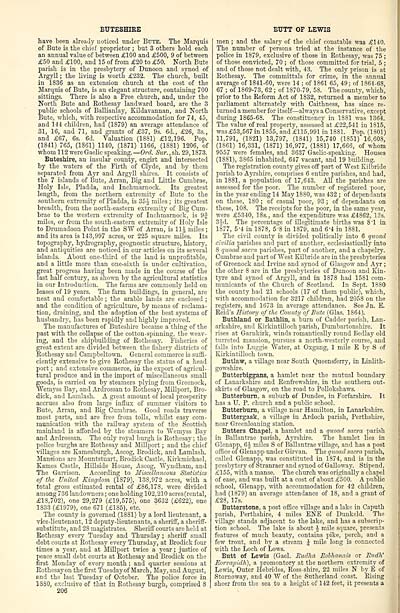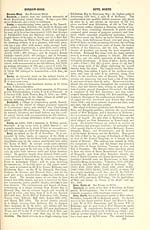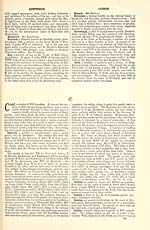Ordnance gazetteer of Scotland > Volume 1
(244) Page 206 - BUT
Download files
Complete book:
Individual page:
Thumbnail gallery: Grid view | List view

BUTESHIRE
have been already noticed under Bute. The Marquis
of Bute is the chief proprietor ; but 3 others hold each
an annual value of between £100 and £500, 9 of between
£50 and £100, and 15 of from £20 to £50. North Bute
parish is in the presbytery of Dunoon and synod of
Argyll ; the living is worth £232. The church, built
in 1836 as an extension church at the cost of the
Marquis of Bute, is an elegant structure, containing 700
sittings. There is also a Free church, and, under the
North Bute and Rothesay landward board, are the 3
public schools of Ballianlay, Kildavannan, and North
Bute, which, with respective accommodation for 74, 45,
and 144 children, had (1879) an average attendance of
31, 16, and 71, and grants of £37, 9s. 6d., £26, 3s.,
and £67, 6s. 6d. Valuation (1881) £12,196. Pop.
(1841) 765, (1861) 1140, (1871) 1166, (1881) 1206, of
whom 112 were Gaelic speaking. — Orel. Sur., sh. 29, 1873.
Buteshire, an insular county, engirt and intersected
by the waters of the Firth of Clyde, and by them
separated from Ayr and Argyll shires. It consists of
the 7 islands of Bute, Arran, Big and Little Cumbrae,
Holy Isle, Pladda, and Inchmarnock. Its greatest
length, from the northern extremity of Bute to the
southern extremity of Pladda, is 35i- miles ; its greatest
breadth, from the north-eastern extremity of Big Cum-
brae to the western extremity of Inchmarnock, is 9j
miles, or from the south-eastern extremity of Holy Isle
to Drumadoon Point in the SW of Arran, is 11J miles ;
and its area is 143,997 acres, or 225 square miles. Its
topography, hydrography, geognostic structure, history,
and antiquities are noticed in our articles on its several
islands. About one-third of the land is unprofitable,
and a little more than one-sixth is under cultivation,
great progress having been made in the course of the
last half century, as shown by the agricultural statistics
in our Introduction. The farms are commonly held on
leases of 19 years. The farm buildings, in general, are
neat and comfortable ; the arable lands are enclosed ;
and the condition of agriculture, by means of reclama-
tion, draining, and the adoption of the best systems of
husbandry, has been rapidly and highly improved.
The manufactures of Buteshire became a thing of the
past with the collapse of the cotton-spinning, the weav-
ing, and the shipbuilding of Rothesay. Fisheries of
great extent are divided between the fishery districts of
Rothesay and Campbeltown. General commerce is suffi-
ciently extensive to give Rothesay the status of a head
port ; and extensive commerce, in the export of agricul-
tural produce and in the import of miscellaneous small
goods, is carried on by steamers plying from Greenock,
Wemyss Bay, and Ardrossan to Rothesay, Millport, Bro-
dick, and Lamlash. A great amount of local prosperity
accrues also from large influx of summer visitors to
Bute, Arran, and Big Cumbrae. Good roads traverse
most parts, and are free from tolls, whilst easy com-
munication with the railway system of the Scottish
mainland is afforded by the steamers to Weniyss Bay
and Ardrossan. The only royal burgh is Rothesay ; the
police burghs are Rothesay and Millport ; and the chief
villages are Kamesburgh, Ascog, Brodick, and Lamlash.
Mansions are Mountstuart, Brodick Castle, Kirkmichael,
Kames Castle, Hillside House, Ascog, Wyndhani, and
The Garrison. According to Miscellaneous Statistics
of the United Kingdom (1879), 138,972 acres, with a
total gross estimated rental of £86,178, were divided
among 736 landowners ; one holding 102,210 acres (rental,
£18,702), one 29,279 (£19,575), one 3632 (£622), one
1833 (£1979), one 671 (£185), etc.
The county is governed (1881) by a lord lieutenant, a
vice-lieutenant, 12 deputy-lieutenants, a sheriff, a sheriff-
substitute, and 28 magistrates. Sheriff courts are held at
Rothesay every Tuesday and Thursday ; sheriff small
debt courts at Rothesay every Thursday, at Brodick four
times a year, and at Millport twice a year ; justice of
peace small debt courts at Rothesay and Brodick on the
first Monday of every month ; and quarter sessions at
Rothesay on the first Tuesday of March, May, and August,
and the last Tuesday of October. The police force in
1880, exclusive of that in Rothesay burgh, comprised 8
206
BUTT OF LEWIS
men; and the salary of the chief constable was £140.
The number of persons tried at the instance of the
police in 1879, exclusive of those in Rothesay, was 75 ;
of those convicted, 70 ; of those committed for trial, 5 ;
and of those not dealt with, 43. The only prison is at
Rothesay. The committals for crime, in the annual
average of 1841-60, were 14 ; of 1861 65, 49 ; of 1864-68,
67 ; of 1869-73, 62 ; of 1870-79, 58. The .county, which,
prior to the Reform Act of 1832, returned a member to
parliament alternately with Caithness, has since re-
turned a member for itself — always a Conservative, except
during 1865-68. The constituency in 1881 was 1364.
The value of real property, assessed at £22,541 in 1815,
was £53,567 in 1855, and £115,991 in 1881. Pop. (1801)
11,791, (1821) 13,797, (1841) 15,740 (1851) 16,608,
(1861) 16,331, (1871) 16,977, (1881) 17,666, of whom
9557 were females, and 3637 Gaelic-speaking. Houses
(1881), 3S65 inhabited, 647 vacant, and 19 building.
The registration county gives off part of West Kilbride
parish to Ayrshire, comprises 6 entire parishes, and had,
in 1881, a population of 17,643. All the parishes are
assessed for the poor. The number of registered poor,
in the year ending 14 May 1SS0, was 432 ; of dependants
on these, 180 ; of casual poor, 93 ; of dependants on
these, 108. The receipts for the poor, in the same year,
were £5340, 18s., and the expenditure was £4862, 13s.
3id. The percentage of illegitimate births was 8"1 in
1877, 5-4 in 1878, 5 '8 in 1879, and 6-4 in 1881.
The civil county is divided politically into 6 quoad
civilia parishes and part of another, ecclesiastically into
8 quoad sacra parishes, part of another, and a chapelry.
Cumbrae and part of West Kilbride are in the presbyteries
of Greenock and Irvine and synod of Glasgow and Ayr ;
the other 8 are in the presbyteries of Dunoon and Kin-
tyre and synod of Argyll, and in 1878 had 1581 com-
municants of the Church of Scotland. In Sept. 1880
the county had 21 schools (17 of them public), which,
with accommodation for 3217 children, had 2058 on the
registers, and 1673 in average attendance. See Jn. E.
Reid's History of the County of Bute (Glas. 1S64).
Buthland or Bathlin, a burn of Cadder parish, Lan-
arkshire, and Kirkintilloch parish, Dumbartonshire. It
rises at Gamkirk, winds romantically round Bedlay old
turreted mansion, pursues a north-westerly course, and
falls into Luggie Water, at Oxgang, 1 mile E by S of
Kirkintilloch town.
Butlaw, a village near South Queensferry, in Linlith-
gowshire.
Butterbiggans, a hamlet near the mutual boimdary
of Lanarkshire and Renfrewshire, in the southern out-
skirts of Glasgow, on the road to Pollokshaws.
Butterburn, a suburb of Dundee, in Forfarshire. It
has a U. P. church and a public school.
Butterburn, a village near Hamilton, in Lanarkshire.
Buttergask, a village in Ardoch parish, Perthshire,
near Greenloaning station.
Butters Chapel, a hamlet and a quoad sacra parish
in Ballantrae parish, Ayrshire. The hamlet lies in
Glenapp, 6J miles S of Ballantrae village, and has a post
office of Glenapp under Girvan. The quoad sacra parish,
called Glenapp, was constituted in 1874, and is in the
presbytery of Stranraer and synod of Galloway. Stipend,
£155, with a manse. The church was originally a chapel
of ease, and was built at a cost of about £500. A public
school, Glenapp, with accommodation for 42 children,
had (1879) an average attendance of 18, and a grant of
£28, 17s.
Butterstone, a post office village and a lake in Caputh
parish, Perthshire, 4 miles ENE of Dunkeld. The
village stands adjacent to the lake, and has a subscrip-
tion school. The lake is about J mile square, presents
features of much beauty, contains pike, perch, and a
few trout, and by a stream | mile long is connected
with the Loch of Lows.
Butt of Lewis (Gael. Rudlia Eolhanais or Rudh'
Eorrapidh), a promontory at the northern extremity of
Lewis, Outer Hebrides, Ross-shire, 22 miles N by E of
Stornoway, and 40 W of the Sutherland coast. Rising
sheer from the sea to a height of 1 42 feet, it presents a
have been already noticed under Bute. The Marquis
of Bute is the chief proprietor ; but 3 others hold each
an annual value of between £100 and £500, 9 of between
£50 and £100, and 15 of from £20 to £50. North Bute
parish is in the presbytery of Dunoon and synod of
Argyll ; the living is worth £232. The church, built
in 1836 as an extension church at the cost of the
Marquis of Bute, is an elegant structure, containing 700
sittings. There is also a Free church, and, under the
North Bute and Rothesay landward board, are the 3
public schools of Ballianlay, Kildavannan, and North
Bute, which, with respective accommodation for 74, 45,
and 144 children, had (1879) an average attendance of
31, 16, and 71, and grants of £37, 9s. 6d., £26, 3s.,
and £67, 6s. 6d. Valuation (1881) £12,196. Pop.
(1841) 765, (1861) 1140, (1871) 1166, (1881) 1206, of
whom 112 were Gaelic speaking. — Orel. Sur., sh. 29, 1873.
Buteshire, an insular county, engirt and intersected
by the waters of the Firth of Clyde, and by them
separated from Ayr and Argyll shires. It consists of
the 7 islands of Bute, Arran, Big and Little Cumbrae,
Holy Isle, Pladda, and Inchmarnock. Its greatest
length, from the northern extremity of Bute to the
southern extremity of Pladda, is 35i- miles ; its greatest
breadth, from the north-eastern extremity of Big Cum-
brae to the western extremity of Inchmarnock, is 9j
miles, or from the south-eastern extremity of Holy Isle
to Drumadoon Point in the SW of Arran, is 11J miles ;
and its area is 143,997 acres, or 225 square miles. Its
topography, hydrography, geognostic structure, history,
and antiquities are noticed in our articles on its several
islands. About one-third of the land is unprofitable,
and a little more than one-sixth is under cultivation,
great progress having been made in the course of the
last half century, as shown by the agricultural statistics
in our Introduction. The farms are commonly held on
leases of 19 years. The farm buildings, in general, are
neat and comfortable ; the arable lands are enclosed ;
and the condition of agriculture, by means of reclama-
tion, draining, and the adoption of the best systems of
husbandry, has been rapidly and highly improved.
The manufactures of Buteshire became a thing of the
past with the collapse of the cotton-spinning, the weav-
ing, and the shipbuilding of Rothesay. Fisheries of
great extent are divided between the fishery districts of
Rothesay and Campbeltown. General commerce is suffi-
ciently extensive to give Rothesay the status of a head
port ; and extensive commerce, in the export of agricul-
tural produce and in the import of miscellaneous small
goods, is carried on by steamers plying from Greenock,
Wemyss Bay, and Ardrossan to Rothesay, Millport, Bro-
dick, and Lamlash. A great amount of local prosperity
accrues also from large influx of summer visitors to
Bute, Arran, and Big Cumbrae. Good roads traverse
most parts, and are free from tolls, whilst easy com-
munication with the railway system of the Scottish
mainland is afforded by the steamers to Weniyss Bay
and Ardrossan. The only royal burgh is Rothesay ; the
police burghs are Rothesay and Millport ; and the chief
villages are Kamesburgh, Ascog, Brodick, and Lamlash.
Mansions are Mountstuart, Brodick Castle, Kirkmichael,
Kames Castle, Hillside House, Ascog, Wyndhani, and
The Garrison. According to Miscellaneous Statistics
of the United Kingdom (1879), 138,972 acres, with a
total gross estimated rental of £86,178, were divided
among 736 landowners ; one holding 102,210 acres (rental,
£18,702), one 29,279 (£19,575), one 3632 (£622), one
1833 (£1979), one 671 (£185), etc.
The county is governed (1881) by a lord lieutenant, a
vice-lieutenant, 12 deputy-lieutenants, a sheriff, a sheriff-
substitute, and 28 magistrates. Sheriff courts are held at
Rothesay every Tuesday and Thursday ; sheriff small
debt courts at Rothesay every Thursday, at Brodick four
times a year, and at Millport twice a year ; justice of
peace small debt courts at Rothesay and Brodick on the
first Monday of every month ; and quarter sessions at
Rothesay on the first Tuesday of March, May, and August,
and the last Tuesday of October. The police force in
1880, exclusive of that in Rothesay burgh, comprised 8
206
BUTT OF LEWIS
men; and the salary of the chief constable was £140.
The number of persons tried at the instance of the
police in 1879, exclusive of those in Rothesay, was 75 ;
of those convicted, 70 ; of those committed for trial, 5 ;
and of those not dealt with, 43. The only prison is at
Rothesay. The committals for crime, in the annual
average of 1841-60, were 14 ; of 1861 65, 49 ; of 1864-68,
67 ; of 1869-73, 62 ; of 1870-79, 58. The .county, which,
prior to the Reform Act of 1832, returned a member to
parliament alternately with Caithness, has since re-
turned a member for itself — always a Conservative, except
during 1865-68. The constituency in 1881 was 1364.
The value of real property, assessed at £22,541 in 1815,
was £53,567 in 1855, and £115,991 in 1881. Pop. (1801)
11,791, (1821) 13,797, (1841) 15,740 (1851) 16,608,
(1861) 16,331, (1871) 16,977, (1881) 17,666, of whom
9557 were females, and 3637 Gaelic-speaking. Houses
(1881), 3S65 inhabited, 647 vacant, and 19 building.
The registration county gives off part of West Kilbride
parish to Ayrshire, comprises 6 entire parishes, and had,
in 1881, a population of 17,643. All the parishes are
assessed for the poor. The number of registered poor,
in the year ending 14 May 1SS0, was 432 ; of dependants
on these, 180 ; of casual poor, 93 ; of dependants on
these, 108. The receipts for the poor, in the same year,
were £5340, 18s., and the expenditure was £4862, 13s.
3id. The percentage of illegitimate births was 8"1 in
1877, 5-4 in 1878, 5 '8 in 1879, and 6-4 in 1881.
The civil county is divided politically into 6 quoad
civilia parishes and part of another, ecclesiastically into
8 quoad sacra parishes, part of another, and a chapelry.
Cumbrae and part of West Kilbride are in the presbyteries
of Greenock and Irvine and synod of Glasgow and Ayr ;
the other 8 are in the presbyteries of Dunoon and Kin-
tyre and synod of Argyll, and in 1878 had 1581 com-
municants of the Church of Scotland. In Sept. 1880
the county had 21 schools (17 of them public), which,
with accommodation for 3217 children, had 2058 on the
registers, and 1673 in average attendance. See Jn. E.
Reid's History of the County of Bute (Glas. 1S64).
Buthland or Bathlin, a burn of Cadder parish, Lan-
arkshire, and Kirkintilloch parish, Dumbartonshire. It
rises at Gamkirk, winds romantically round Bedlay old
turreted mansion, pursues a north-westerly course, and
falls into Luggie Water, at Oxgang, 1 mile E by S of
Kirkintilloch town.
Butlaw, a village near South Queensferry, in Linlith-
gowshire.
Butterbiggans, a hamlet near the mutual boimdary
of Lanarkshire and Renfrewshire, in the southern out-
skirts of Glasgow, on the road to Pollokshaws.
Butterburn, a suburb of Dundee, in Forfarshire. It
has a U. P. church and a public school.
Butterburn, a village near Hamilton, in Lanarkshire.
Buttergask, a village in Ardoch parish, Perthshire,
near Greenloaning station.
Butters Chapel, a hamlet and a quoad sacra parish
in Ballantrae parish, Ayrshire. The hamlet lies in
Glenapp, 6J miles S of Ballantrae village, and has a post
office of Glenapp under Girvan. The quoad sacra parish,
called Glenapp, was constituted in 1874, and is in the
presbytery of Stranraer and synod of Galloway. Stipend,
£155, with a manse. The church was originally a chapel
of ease, and was built at a cost of about £500. A public
school, Glenapp, with accommodation for 42 children,
had (1879) an average attendance of 18, and a grant of
£28, 17s.
Butterstone, a post office village and a lake in Caputh
parish, Perthshire, 4 miles ENE of Dunkeld. The
village stands adjacent to the lake, and has a subscrip-
tion school. The lake is about J mile square, presents
features of much beauty, contains pike, perch, and a
few trout, and by a stream | mile long is connected
with the Loch of Lows.
Butt of Lewis (Gael. Rudlia Eolhanais or Rudh'
Eorrapidh), a promontory at the northern extremity of
Lewis, Outer Hebrides, Ross-shire, 22 miles N by E of
Stornoway, and 40 W of the Sutherland coast. Rising
sheer from the sea to a height of 1 42 feet, it presents a
Set display mode to: Large image | Transcription
Images and transcriptions on this page, including medium image downloads, may be used under the Creative Commons Attribution 4.0 International Licence unless otherwise stated. ![]()
| Gazetteers of Scotland, 1803-1901 > Ordnance gazetteer of Scotland > Volume 1 > (244) Page 206 - BUT |
|---|
| Permanent URL | https://digital.nls.uk/97371694 |
|---|
| Attribution and copyright: |
|
|---|---|

